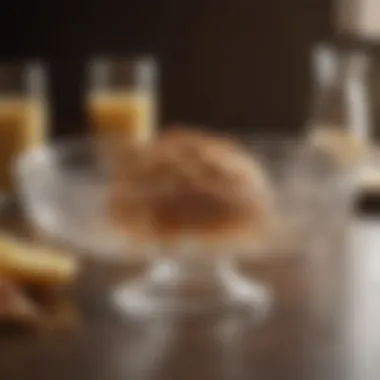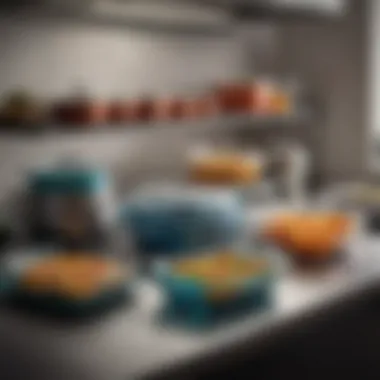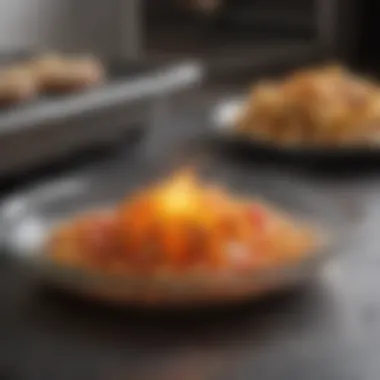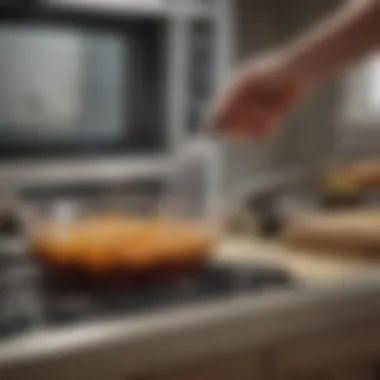Understanding Glass Dishes for Oven Use


Intro
Glass dishes have gained favor in culinary practices due to their versatility and aesthetic appeal. As many kitchen enthusiasts turn to glass for baking and roasting, understanding its functional properties becomes essential. This section offers insight into the advantages and considerations of utilizing glass cookware in the oven.
Glass cookware is designed to withstand high temperatures. However, not all glass is created equally. Different types of glass have varying heat tolerances and suitability for oven use. When used properly, glass dishes can enhance the cooking process, allowing for even heat distribution and good visibility of food as it cooks.
Beyond functionality, glass is also a healthier option since it does not react with food. This characteristic allows for the preservation of flavors and nutrients, making glass an attractive choice for those mindful of their diet. Yet, care must be taken to prevent thermal shock, which can lead to cracking or breaking.
In the sections that follow, we explore specific glass dish types, their heat resilience, safety precautions, and the interplay of glass with various food ingredients. Our aim is to equip the reader with knowledge to maximize the benefits of cooking with glass, while also being aware of potential drawbacks.
The Basics of Glass Cookware
Understanding the fundamentals of glass cookware is essential when exploring its use in culinary settings. This section delves into both the definition and composition of glass cookware, along with an overview of different types available. By grasping these basics, readers can make informed decisions about their cooking tools.
Definition and Composition of Glass Cookware
Glass cookware refers to any cooking vessel made predominantly from glass. Unlike metal or ceramic, glass is a non-reactive material. This characteristic is crucial as it ensures that glass does not interact with ingredients, allowing for pure flavor in dishes. The primary components of glass cookware often include silica, soda ash, and lime.
The formulation of these materials influences the heat resistance and durability of glass dishes. Standard glass, which is less resilient, has lower temperature tolerance. On the other hand, borosilicate glass—commonly used in high-quality cookware—can withstand extreme temperature changes. This makes it suitable for both oven and microwave use. Moreover, adequately tempered glass can resist thermal shock, meaning that it will not break when exposed to sudden temperature variations.
Types of Glass Cookware Available
Various types of glass cookware cater to different cooking needs. These include:
- Baking Dishes: Often rectangular and deep, ideal for casseroles and roasts, commonly made of borosilicate glass.
- Pie Plates: Shallow and round, these allow for even baking of pie crusts and toppings.
- Glass Measuring Cups: Used for both measuring and heating ingredients, versatile for both cooking and baking tasks.
- Storage Containers: While primarily for storage, many glass containers can withstand oven temperatures, useful for reheating without transferring food.
It is crucial to select the right type of glass cookware for each culinary task to achieve the best results. With the right knowledge, cooks can utilize glass dishes confidently, ensuring their cooking remains both efficient and effective.
Heat Resistance of Glass Dishes
When using glass dishes in the oven, understanding their heat resistance is essential. This aspect directly impacts the safety and quality of cooking. Glass dishes are made from various types of glass, each with unique properties related to temperature tolerance. Knowing these properties can help cooks make informed decisions about their cookware choices, thus enhancing the cooking experience.
Temperature Tolerance of Different Glass Types
Different types of glass cookware are designed to withstand varying degrees of heat. For instance, borosilicate glass, such as Pyrex, is known for its high temperature resistance, allowing it to endure temperatures up to about 400°F without breaking. Regular glass, on the other hand, usually has a lower tolerance, typically below 350°F.
It is crucial to check the manufacturer’s instructions, as each product can have specific guidelines. Therefore, using glass dishes with guarantees for high heat can significantly influence the cooking results. Cookware made from tempered glass also offers better resistance to thermal shock, reducing the risk of breakage during cooking.
Impact of Rapid Temperature Changes
Rapid temperature changes can have damaging effects on glass dishes. This phenomenon, known as thermal shock, occurs when a glass dish is exposed to extreme heat or cold. For example, taking a glass dish from a hot oven and placing it on a cold countertop can lead to cracking or shattering.
To prevent such incidents, a few precautions should be observed:
- Gradually preheat the oven: Instead of placing glass dishes in a cold oven, ensure that the oven reaches the desired temperature before inserting the dish.
- Avoid drastic temperature shifts: When removing glass dishes from the oven, do not put them directly into cold water or on cold surfaces.
- Use oven mitts or heat-resistant pads: This minimizes direct contact with cold air or surfaces that could cause the glass to cool too quickly.
Understanding these concepts empowers cooks to maximize the efficiency and longevity of their glass cookware while minimizing risks associated with improper use.
Advantages of Using Glass Dishes in the Oven
Using glass dishes in the oven presents several advantages that contribute to their increasing popularity among home cooks and culinary professionals. Glass cookware is valued not only for its aesthetic appeal but also for its unique cooking properties. By understanding why glass dishes excel in oven use, one can make informed decisions when preparing meals.


Even Heat Distribution
One of the primary benefits of glass dishes is their ability to distribute heat evenly. Unlike metal pans that may have hot spots, glass promotes uniform cooking. Its non-porous surface allows for consistent heat absorption and retention. This characteristic is particularly useful when baking items like casseroles and cakes, where even cooking is vital to achieving desirable textures and flavors.
- Enhanced Performance: The even heat distribution reduces the risk of undercooked or overcooked sections within a dish.
- Improved Taste: Dishes cooked with uniform heat often end up with better flavors, as ingredients properly blend and develop.
- Versatile Use: Glass dishes are excellent for various cooking techniques, from baking to slow-roasting, thanks to their reliable heat characteristics.
It is important to note that while glass provides these advantages, one should still monitor cooking times and temperatures for optimal results.
Non-Reactive Properties of Glass
Another significant advantage of using glass dishes in the oven is their non-reactive nature. Glass does not react with acidic or alkaline foods like tomatoes or citrus products. This property ensures that the flavors of the ingredients remain unaffected during cooking and prevents unwanted chemical reactions that can spoil the meal.
- Flavor Maintenance: Foods cooked in glass maintain their intended flavors without interference.
- Health Considerations: Non-reactive cookware helps prevent leaching of metals or chemicals into food, making glass a safer choice for cooking.
- Long-lasting: Glass dishes do not retain odors or stains, promoting a healthier cooking environment.
These non-reactive characteristics enhance both the safety and quality of meals prepared in glass dishes.
Visibility During Cooking
Visibility is another advantage that glass dishes provide. The transparency of glass allows cooks to monitor their dish while it is cooking. This ability is especially beneficial when baking and roasting, where changes in color and texture signify doneness.
- Easier Monitoring: You can check the state of your food without needing to open the oven, which helps maintain consistent temperatures.
- Timing Accuracy: Being able to see the progression of cooking aids in timing the dishes accurately, resulting in better overall outcomes.
- Aesthetic Appeal: Glass dishes often look appealing in presentations, allowing them to go directly from the oven to the table without the need to transfer food.
As a final point, the advantages of using glass dishes in the oven are significant. They offer an optimal cooking environment that enhances the culinary experience through even heat distribution, flavor retention, and visibility during the cooking process. By understanding these benefits, both novice cooks and seasoned chefs can elevate their cooking capabilities.
"Glass cookware is not just a pretty face; it brings functionality and performance to the kitchen."
Disadvantages and Limitations of Glass Dishes
When choosing cookware, understanding the disadvantages and limitations of glass dishes is crucial for informed decision-making. These aspects provide insights into conditions where glass might not be the best choice in the culinary world. While glass dishes offer many advantages, acknowledging the potential downsides offers a balanced perspective for the reader.
Risk of Breakage
One of the most significant disadvantages of glass dishes is their susceptibility to breakage. Glass cookware, while durable under normal cooking conditions, can shatter if exposed to sudden temperature changes or impact. This risk is notably higher when trying to transfer a glass dish directly from the refrigerator to a hot oven. As a best practice, always allow glass dishes to acclimate to room temperature before introducing them to heat.
Additionally, some users may find that particular glass types, such as tempered glass, offer a degree of resistance to breakage. But care still is needed to handle them gently. Avoid stacking heavy items on top of glass dishes during storage and ensure that they are not in contact with hard surfaces that might cause chips or cracks. The thinness of some glassware also contributes to its fragility. Therefore, users should weigh the choice of glass against these possible risks.
Potential for Uneven Browning
Another limitation of glass cookware is the potential for uneven browning. Unlike metal pans, which allow heat to conduct more efficiently, glass may not distribute heat in the same manner. This unevenness can lead to certain areas of a dish cooking faster than others, presenting a challenge when roasting or baking food that requires a consistent level of doneness.
When dealing with baking, some cooks may find that items may not achieve that desired crispy finish typical of metal or stoneware. This outcome can be particularly disappointing when preparing dishes that benefit from a golden-brown appearance. For those who strive for aesthetic and textural perfection in their meals, this might pose as a disadvantage.
To mitigate this issue, consider rotating the dish halfway through the cooking process. This practice can help achieve a more uniform cooking result. Moreover, combining glass cookware with other materials, such as a metal tray, can enhance the overall cooking experience and promote better browning.
"Being aware of the limitations of glass cookware allows for better meal planning and preparation strategies."
Best Practices for Using Glass Dishes in the Oven
When using glass dishes in the oven, understanding best practices is crucial for achieving optimal results. Glass cookware has unique properties that can impact cooking times and food quality. Following established techniques will ensure safety and improve the overall cooking experience.
Preheating and Cooking Techniques
Preheating the oven is an essential step for glass cookware. Glass material heats evenly, which means it can retain and distribute heat well. However, placing a cold glass dish in a hot oven may cause thermal shock, resulting in breakage. Always preheat the oven before placing any glass dish inside.


To cook effectively, utilize low to moderate heat settings. Most glass dishes can withstand temperatures up to 425°F. For recipes that require higher heat, consider other cookware materials. Opting for glass dishes often means adjusting cooking times slightly to account for their heat retention properties.
Some techniques to keep in mind include:
- Avoid using glass dishes for broiling, as this may exceed their heat tolerance.
- Use recommended cooking times from recipes and adjust based on individual oven performance.
- Rotate dishes halfway through cooking for even browning and cooking.
Recommended Oven Temperatures
When using glass dishes, the recommended oven temperatures typically range from 325°F to 375°F. These temperatures allow the glass to perform optimally without risking damage. Recipes that demand higher temperatures should be carefully evaluated before using glass.
For best results, consider the following:
- Baking: Usually, 350°F works well for most baked goods.
- Roasting: 375°F is suitable for roasting vegetables or meats in glass dishes.
- Casseroles: 325°F ensures slow cooking while maintaining moisture.
Using an oven thermometer can help monitor actual temperatures, leading to better cooking outcomes. Adhering to these temperature guidelines helps prevent accidents and maintains the integrity of glass cookware.
Caring for Glass Cookware
Caring for glass cookware is crucial for both its longevity and efficiency in the oven. Glass dishes are favored not only for their aesthetic appeal but also for their functionality. However, improper care can lead to scratches, stains, and even breakage. With proper maintenance, glass cookware can provide years of reliable use, standing up to both daily cooking and special occasions.
Cleaning Techniques
Cleaning glass dishes requires attention to detail to protect the surface from scratches and maintain their clarity. Here are some effective cleaning methods:
- Immediate Rinsing: After use, rinse the dish with warm water immediately to remove any food residue. This prevents staining and makes deeper cleaning easier later.
- Gentle Scrubbing: Use a non-abrasive sponge or cloth while cleaning. Abrasive pads can lead to micro-scratches that collect grime and affect the appearance.
- Soaking: For stubborn stains, soak the dish in hot soapy water for about 30 minutes. This loosens food particles and makes them easier to remove.
- Baking Soda Paste: Create a paste of baking soda and water for tough stains. Apply it to the stained area and let it sit for a while before wiping clean.
- Avoiding Extreme Temperatures: Do not subject glass dishes to sudden temperature changes, such as soaking a hot dish in cold water, as it may cause thermal shock and lead to breakage.
By following these cleaning techniques, one can maintain the pristine condition of glass cookware while ensuring it remains safe for its next use in the oven.
Storage Practices
Proper storage of glass cookware is integral to its durability. Here are some recommended practices:
- Stacking with Care: If stacking glass dishes, place a soft cloth or paper towel between them. This avoids scratches and minimizes direct contact.
- Designated Storage Area: Choose a specific place for glass cookware that is off high-traffic points in the kitchen, reducing the chance of accidental knocks.
- Avoiding Overcrowding: Keep the storage area organized. Overcrowded spaces can lead to mishaps and increase the risk of chips or cracks.
- Temperature Awareness: Store glass dishes in a temperature-controlled environment to avoid avoidance of extreme cold or heat, which can weaken the structure over time.
Proper care and informed storage can greatly extend the life of your glass cookware.
In summary, maintaining glass cookware with effective cleaning methods and thoughtful storage practices is key to enhancing its usability and appearance. This not only ensures that the dishes serve well in cooking but also retains their aesthetic quality for years to come.
Common Misconceptions about Glass and Oven Use
Understanding common misconceptions surrounding glass dishes and their use in the oven is essential. Misunderstandings can lead to improper use, resulting in a less optimal cooking experience or even accidents. Clear clarification of these points benefits home cooks looking to make informed decisions while using glass cookware.
Glass Can't Withstand High Temperatures
One major myth is that glass cookware is not suitable for high temperatures. This notion stems from general concerns about the fragility of glass and its potential to shatter. However, the reality is that most high-quality glass cookware is designed to endure considerable heat levels, specifically tempered glass. Brands like Pyrex and OXO offer glass dishes engineered to handle temperatures up to 450°F or more.
Despite this engineering, it is critical for users to respect the specified temperature limits of their glass dishes. Glass cookware can break, but this may not be due to its inability to withstand heat, rather, it can result from drastic temperature changes. For instance, placing a cold glass dish directly into a preheated oven may lead to breakage. Consequently, understanding the specific heat resistance of your glass cookware is highly recommended.
"Avoiding extreme temperature changes is vital for glass cookware to maintain its integrity."
Glass Dishes Require Special Care


Another misconception is that glass dishes demand special care not required by other cookware materials. While glass cookware does require certain best practices for longevity, this differs from being overly complicated.
For example, glass dishes should typically be cleaned with non-abrasive materials to avoid scratching, and they are generally dishwasher safe, which simplifies maintenance. Moreover, some users fear that glass dishes need to be stored with extra precautions due to their fragility. While careful handling is advisable, glass can be easily stackable if stored properly.
In practical terms, one often needs to avoid sudden exposure to extreme temperatures, but this is a standard rule for many cookware types. Hence, while glass dishes have unique aspects, they do not necessarily require special or complicated care beyond basic cooking ware practices.
In summary, dispelling these misconceptions is crucial as it empowers users. It allows them to utilize their glass cookware effectively and safely in their culinary practices.
Comparative Analysis with Other Cookware Materials
In this section, we will explore the comparative aspects of glass cookware against metal and ceramic alternatives. This analysis is crucial because it helps consumers understand the strengths and weaknesses of glass dishes, informing their choices in the kitchen. Each material offers unique benefits and considerations that directly influence cooking outcomes, durability, and overall satisfaction with culinary exploits.
Glass vs. Metal Cookware
Glass cookware presents a list of advantages when compared to metal cookware. One significant benefit is the non-reactive nature of glass. Unlike metals like aluminum or stainless steel, glass does not interact with acidic or alkaline foods. This can lead to better flavor retention in dishes, particularly when cooking tomatoes or citrus-based recipes. Moreover, glass allows for direct visibility of the cooking process. As a result, cooks can monitor browning and moisture levels without needing to open the oven, thereby preventing heat loss.
However, metal cookware excels in heat conduction. Aluminum and stainless steel provide rapid and consistent heat distribution, making them favorable for certain high-temperature cooking tasks. Metal can also be more durable, withstanding more wear and tear in certain scenarios. Although glass dishes are heat-resistant, they may crack or shatter if exposed to sudden temperature shifts, which is less likely with metal.
"When it comes to cooking, selecting the right materials can significantly affect the taste and texture of your dishes."
A quick summary of key differences is as follows:
- Heat Distribution: Metal heats quickly and evenly; glass offers slower, moderate heating.
- Reactivity: Glass is non-reactive; metals may alter flavors in acidic meals.
- Visibility: Glass allows visibility during cooking; metal lacks transparency.
- Durability: Metal tends to be more durable; glass is more fragile but often safer for certain types of cooking.
Glass vs. Ceramic Cookware
Ceramic cookware provides an attractive alternative to glass, known for its aesthetic appeal and even heat distribution. Like glass, ceramic is also non-reactive, which makes it suitable for a variety of dishes. It typically retains heat well, leading to effective cooking and reheating of meals. This can be particularly beneficial for slow-cooking processes, where maintaining a consistent temperature is essential.
However, ceramic cookware may not be as versatile as glass when it comes to direct oven use. While some advanced ceramics boast high-temperature resistance, others may not be suitable for the oven. Glass dishes generally are oven safe, making them a more reliable option for various baking needs. Moreover, glass cookware is usually dishwasher-safe, simplifying post-cooking cleanup.
To summarize the essential distinctions:
- Aesthetic Appeal: Ceramic offers more visual options; glass provides clarity.
- Heat Retention: Both materials excel, but ceramics may struggle at higher temperatures.
- Durability: Glass can be more fragile than certain ceramics; however, high-quality ceramic can also chip.
- Oven Safety: Glass is typically always oven-safe; some ceramic pieces may not be.
Understanding these comparisons is vital for informed choice in kitchenware. Each type of cookware brings its unique benefits and challenges, and knowing these helps enhance cooking experiences and outcomes.
The End
In summation, the utility of glass dishes within culinary practices is both refined and extensive. These dishes are not just aesthetically pleasing; they offer notable advantages that enhance the cooking experience. With glass cookware, one can achieve even heat distribution. This is crucial for consistent cooking results. The non-reactive nature of glass means there will be no unwanted flavors or chemicals leaching into your food. This makes it suitable for various recipes, especially those utilizing acidic ingredients such as tomatoes or citrus. Additionally, glass's transparency enables cooks to monitor their meals without opening the oven door, preserving the cooking temperature as well as moisture.
However, it's important to consider some challenges as well. For instance, glass can break if not handled properly. It is susceptible to thermal shock when subjected to sudden temperature changes. Being aware of these limitations can ensure greater success when using glass dishes in the oven.
"Understanding how glass cookware interacts with heat can prevent many kitchen mishaps."
Ultimately, incorporating glass dishes into your baking repertoire can elevate your cooking. Familiarity with their properties, advantages, and limitations is key to maximizing their use in the modern kitchen.
Summarizing the Utility of Glass in Culinary Practices
The primary takeaway revolves around the practical benefits that glass cookware offers. Their ability to withstand oven heat while maintaining food integrity makes them desirable. Not to mention, glass dishes are often dishwasher safe, which simplifies cleanup. Additionally, their design means they are more versatile than one might think. These dishes can go from the oven to the table, providing an appealing presentation. This dual functionality is especially appealing to food lovers.
Furthermore, their durability leads to cost savings. While some may initially think glass is more fragile, the quality of many contemporary glass dish brands negates this notion. Proper care leads to lasting use. Overall, the investment in good-quality glass dishes is one that pays dividends, both in functionality and aesthetic appeal.
Future Trends in Glass Cookware Design
As culinary trends evolve, so do the designs of glass cookware. The future seems to lie in innovation. Manufacturers are exploring ways to enhance the aesthetics and functionality of glass dishes. One notable trend is the integration of tempered glass. This material is engineered to resist high temperatures and sudden changes in heat better than traditional glass. This could further mitigate the risks associated with breakage.
Another trend is the introduction of decorative features that make glass dishes more appealing. For example, colorful coatings or intricate designs may soon be commonplace. These enhancements will make them as much a part of the dining experience as the food itself.
Smart technology is also on the horizon; some companies are working on glass cookware that can connect to smart kitchen devices. This could offer greater precision in terms of cooking temperatures or timing, aligning with the trend of integrating technology into the culinary field.







